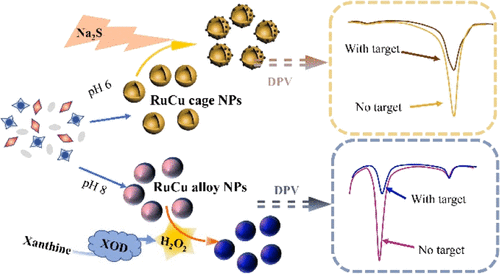当前位置:
X-MOL 学术
›
Anal. Chem.
›
论文详情
Our official English website, www.x-mol.net, welcomes your
feedback! (Note: you will need to create a separate account there.)
RuCu Cage/Alloy Nanoparticles with Controllable Electroactivity for Specific Electroanalysis Applications
Analytical Chemistry ( IF 6.7 ) Pub Date : 2021-09-15 , DOI: 10.1021/acs.analchem.1c03182 Wangwang Zheng 1 , Jie Yao 1 , Yuan Zhao 1
Analytical Chemistry ( IF 6.7 ) Pub Date : 2021-09-15 , DOI: 10.1021/acs.analchem.1c03182 Wangwang Zheng 1 , Jie Yao 1 , Yuan Zhao 1
Affiliation

|
Electrochemical nanotags with controllable and multiresponse electroactivity have a great capacity for overcoming the drawbacks of limited target monitoring and inaccurate detection results for electrochemical sensors. In this contribution, double electro-oxidative Ru and Cu metals were integrated into RuCu nanostructures for the generation of dual electro-oxidative signals. A facial approach was proposed for the controllable fabrication of RuCu cage nanoparticles (NPs) and RuCu alloy NPs by simply adjusting the pH value of the reaction system. RuCu cage NPs and RuCu alloy NPs demonstrated inherent different electro-oxidative responses owing to the remarkable distinction of structures with different metal valences. RuCu cage NPs showed a single electro-oxidization peak at 0.84 V, assigned to the exposure of more Ru0 electroactive sites on the hollow cage structures. RuCu alloy NPs illustrated dual electro-oxidization peak at 0.84 and −0.16 V, attributing to the presence of Ru0 and Cu+ electroactive sites on the alloy structures, respectively. RuCu cage NPs and RuCu alloy NPs served as specific electroactive tags, achieving the selective monitoring of Na2S and ratiometric electrochemical detection of xanthine in monosodium glutamate, respectively. The limits of detection were as low as 27 pM for Na2S and 70 nM for xanthine. The rational design of multimetal nanostructures holds enormous potential for the generation of multiresponse electroactivity with the impetus for exploring the capacity of specific electrochemical sensing.
中文翻译:

用于特定电分析应用的具有可控电活性的 RuCu 笼/合金纳米粒子
具有可控和多响应电活性的电化学纳米标签对于克服电化学传感器目标监测有限和检测结果不准确的缺点具有很大的能力。在这一贡献中,双电氧化 Ru 和 Cu 金属被整合到 RuCu 纳米结构中,以产生双电氧化信号。提出了一种通过简单地调节反应体系的 pH 值来可控制造 RuCu 笼状纳米粒子 (NPs) 和 RuCu 合金纳米粒子的面部方法。由于不同金属价态结构的显着差异,RuCu 笼状纳米颗粒和 RuCu 合金纳米颗粒表现出固有的不同电氧化反应。RuCu 笼状纳米颗粒在 0.84 V 处显示出单个电氧化峰,归因于更多 Ru 0的暴露空心笼结构上的电活性位点。RuCu 合金纳米颗粒在 0.84 和 -0.16 V 处显示出双电氧化峰,这分别归因于合金结构上存在 Ru 0和 Cu +电活性位点。RuCu笼状纳米颗粒和RuCu合金纳米颗粒作为特定的电活性标签,分别实现了Na 2 S的选择性监测和味精中黄嘌呤的比例电化学检测。Na 2 S的检测限低至 27 pM ,黄嘌呤的检测限低至70 nM。多金属纳米结构的合理设计具有产生多响应电活性的巨大潜力,并推动探索特定电化学传感的能力。
更新日期:2021-09-28
中文翻译:

用于特定电分析应用的具有可控电活性的 RuCu 笼/合金纳米粒子
具有可控和多响应电活性的电化学纳米标签对于克服电化学传感器目标监测有限和检测结果不准确的缺点具有很大的能力。在这一贡献中,双电氧化 Ru 和 Cu 金属被整合到 RuCu 纳米结构中,以产生双电氧化信号。提出了一种通过简单地调节反应体系的 pH 值来可控制造 RuCu 笼状纳米粒子 (NPs) 和 RuCu 合金纳米粒子的面部方法。由于不同金属价态结构的显着差异,RuCu 笼状纳米颗粒和 RuCu 合金纳米颗粒表现出固有的不同电氧化反应。RuCu 笼状纳米颗粒在 0.84 V 处显示出单个电氧化峰,归因于更多 Ru 0的暴露空心笼结构上的电活性位点。RuCu 合金纳米颗粒在 0.84 和 -0.16 V 处显示出双电氧化峰,这分别归因于合金结构上存在 Ru 0和 Cu +电活性位点。RuCu笼状纳米颗粒和RuCu合金纳米颗粒作为特定的电活性标签,分别实现了Na 2 S的选择性监测和味精中黄嘌呤的比例电化学检测。Na 2 S的检测限低至 27 pM ,黄嘌呤的检测限低至70 nM。多金属纳米结构的合理设计具有产生多响应电活性的巨大潜力,并推动探索特定电化学传感的能力。









































 京公网安备 11010802027423号
京公网安备 11010802027423号